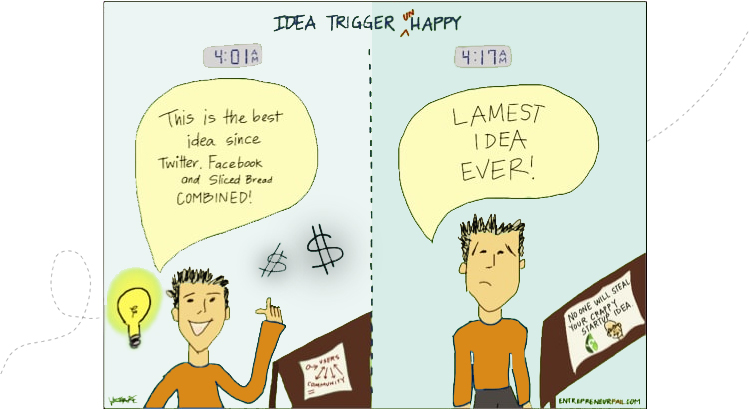Side Hustle Like A Pro
How to turn your passion in to a successful business that delivers 10x ROI
Did you know more than 44 million Americans have a side hustle? And 76% love their side hustle more than their primary jobs.
Some of the biggest businesses today began as side hustles.
Did you know more than 44 million Americans have a side hustle? And 76% love their side hustle more than their primary jobs.
Some of the biggest businesses today began as side hustles.
Apple is the result of 2 guys tinkering away in their garage after work. Instagram started from a rented desk during evenings and weekends when the founders weren’t at their day jobs.
Udemy, WeWork, Groupon, Khan Academy, Oculus… the list of side hustles becoming million dollar businesses is long.
A side hustle is when you spend 90-95% of your time on a full time job that pays bills and you use the remaining 5-10% of your time to work on a new idea that interests you. It might be a hobby, something you love doing, or just an interesting idea that seems worth exploring.
Along the way 2 things happen:
1) You fall in love with the hustle and put all your energies in to making it work
2) Life takes over and you never take the hustle off the ground
As entrepreneurs, most of us are usually bubbling with ideas. It’s not in our nature to keep doing the same thing over and over again. We have this need to multitask and chase after shiny new things.
But before you go chasing after every idea, find one that works for you.
Finding an Idea That Works For You

Of the thousand ideas running through your mind, not all are going to work. In fact what sounds like the next unicorn may be the lamest idea ever when you sit down and evaluate its potential.

Image Source: https://fi.co/insight/how-to-embrace-failure-as-you-transition-from-employee-to-entrepreneur
As entrepreneurs we are always looking at the next way to build our business, the next business we want to build, the next idea we want to pursue, and how not to limit our impact on the world.
There is so much to do!
How to find out what’s the best idea to pursue and how not to be overwhelmed while pursuing it?
Here is a 4-step system that I apply it to find my next opportunity. It helps me determine if my next business idea is the right one. I call it LERR – Leverage, Ease, Risk, and Reward.
Leverage
Ease
Risk
Return
The idea with the highest score is the one with the most potentia
Here’s how I evaluated Zentrepreneur against the idea of me building a software platform or an ecommerce engine.


Clearly, based on the scores, it made business sense to invest my time and efforts in to Zentrepreneur.
Once you’ve determined which idea works for you, it’s time to see if it’s worth it in your current reality.
Is Your Side Hustle Worth it?
Not every idea is worth staking it all on. Not every side hustle can become your main business..
8 out of 10 entrepreneurs fail within the first 18 months. Don’t be one of them.
You need to make some well thought through decisions before you plunge head first in to your next big idea.
How do you do that?
Figure out if it’s going to work out
Look at your side hustle as just that – a side hustle.
You don’t have to nail it when you get started.
You don’t have to be perfect.
You don’t have to get it done on a very aggressive timeline.
Any great business that goes profitable takes a bit of time for it to get set up, to get some traction, to get some clients, to have its own life. Thinking your side hustle is going to work out over a weekend is a bit of an over expectation.
Give yourself a reasonable timeline. It’s a company – you need time to lay the right foundation, find the right message, clarify it, find your clients, get feedback from them, and see if it even works or makes sense, or if it’s just a waste of time.
Figure out your numbers.
Once you get that initial feedback from people whether your product or service actually has a market, the next step is to figure out if it can generate enough money to sustain your lifestyle.
All of us have a baseline number, money that we need to live on, to pay bills etc.
If you jump in to your side hustle without a plan to meet that baseline you’ll fins that money dries up very quickly. So unless you have huge savings or someone to support you financially, you will end up in a big pile of debt.
And that’s not what you want, especially if you are building something you love. If you have to struggle financially, you’ll end up resenting it. You’ll lose motivation. And you will lose passion and drive.
So if you really really want your side hustle to work, make a plan to meet and exceed that baseline. That’s what brings us to goal setting.
Set your goals.
Now that you know your baseline, set a timeline to achieve that revenue. Then create a path to match that goal. How are you going to make $XX every month? Can you create enough revenue in a consistent way that you can quit your job and focus on your passion?
When you achieve that baseline over and over again, month on month, THAT is when your side hustle is ready to become your main hustle.
Now weigh your options – do you want to continue doing this on the side or are you willing to let everything else go and jump in.
In a nutshell, when considering a side hustle, this is what you need to do:
